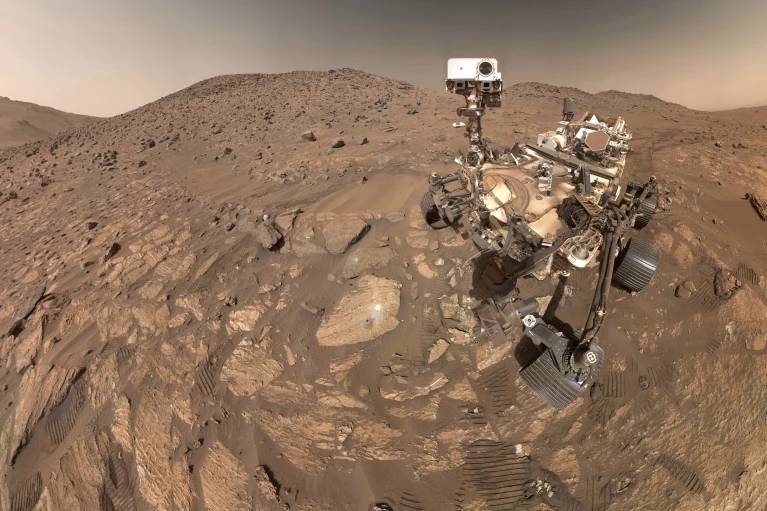
©NASA via AP
Pre-reading questions:
I will read each question. Then, please answer them.
- Do you know what space rovers are? If so, how important do you think they are for space exploration? If not, are you interested in outer space? Why or why not?
- Have you ever climbed a big mountain or a tall wall before? If so, how difficult was it? If not, would you ever try it?
Vocabulary:
I will read the words, meanings, and sample sentences. Then, repeat after me.
- sample /SAM-puhl/
- slope /slohps/
- link /lingk/
- detailed /DEE-teyld/
- analysis /uh-NAL-uh-sis/
[noun] – a small part or amount of something that is tested or examined
The scientist collected samples of the soil for testing.
[noun] – a surface that lies at an angle to the horizontal so that some points on it are higher than others
The children enjoy sledding down the snowy slopes in winter.
[verb] – to make a connection between two or more people, things, or ideas
Eating healthy foods is often linked to better health.
[adjective] – including many small facts or aspects
The map provides a detailed view of the area.
[noun] – the process of studying or examining something in detail in order to understand or explain it
The scientist conducted an analysis of the water to check its purity.
Article reading:
Please read the whole article. Then, I will check your pronunciation and intonation.
NASA’s Perseverance rover has begun a difficult mission on Mars, aiming to climb to the top of Jezero Crater. This mission, which started three and a half years after the rover’s landing, is part of NASA’s ongoing exploration of Mars. The rover will ascend 305 meters from the crater’s bottom, where it has been collecting rock samples since 2021. The primary objective is to gather new rock samples that may provide crucial insights into Mars’ ancient climate and the possibility of past life. Scientists are particularly interested in how Mars’ geological history could reveal important information about the formation of rocky planets like Mars and Earth.
The journey to the crater’s rim will be challenging, as the rover must navigate rocky terrain and steep slopes with inclines of up to 23 degrees. This exploration is expected to take several months. The scientific community is especially interested in the bedrock at the top of the crater, which might contain evidence of ancient hydrothermal activity. On Earth, similar conditions have been linked to the emergence of life, making this mission critical for understanding whether Mars could have supported life in the past. NASA is also investigating ways to bring these rock samples back to Earth for detailed analysis, which could offer further insights into the planet’s history and evolution.
The journey to the crater’s rim will be challenging, as the rover must navigate rocky terrain and steep slopes with inclines of up to 23 degrees. This exploration is expected to take several months. The scientific community is especially interested in the bedrock at the top of the crater, which might contain evidence of ancient hydrothermal activity. On Earth, similar conditions have been linked to the emergence of life, making this mission critical for understanding whether Mars could have supported life in the past. NASA is also investigating ways to bring these rock samples back to Earth for detailed analysis, which could offer further insights into the planet’s history and evolution.
Comprehension questions
I will read each question. Then, please answer them based on the article.
- What has the Perseverance rover been doing since 2021 at the bottom of Jezero Crater?
- What does NASA hope to achieve by bringing the rock samples back to Earth?
- How high is the Perseverance rover expected to climb during this mission?
- What is the difficulty the Perseverance rover might face during its journey to the crater’s rim?
- How long after the Perseverance rover’s landing did this new mission start?
Discussion questions
I will read each question. Then, please answer them.
- Have you ever visited a science museum or attended a space-related event? If so, what did you learn about Mars or space exploration? If not, would you be interested in visiting one to learn more about Mars? Why or why not?
- If you could ask the Perseverance rover one question about its journey on Mars, what would it be, and why?
- Do you agree that exploring Mars’ ancient climate is essential for understanding the history of our own planet?
- What do you think are the biggest challenges that the Perseverance rover will face as it climbs to the top of Jezero Crater?
- If NASA succeeds in bringing rock samples back to Earth, how do you think this will impact future space exploration missions?